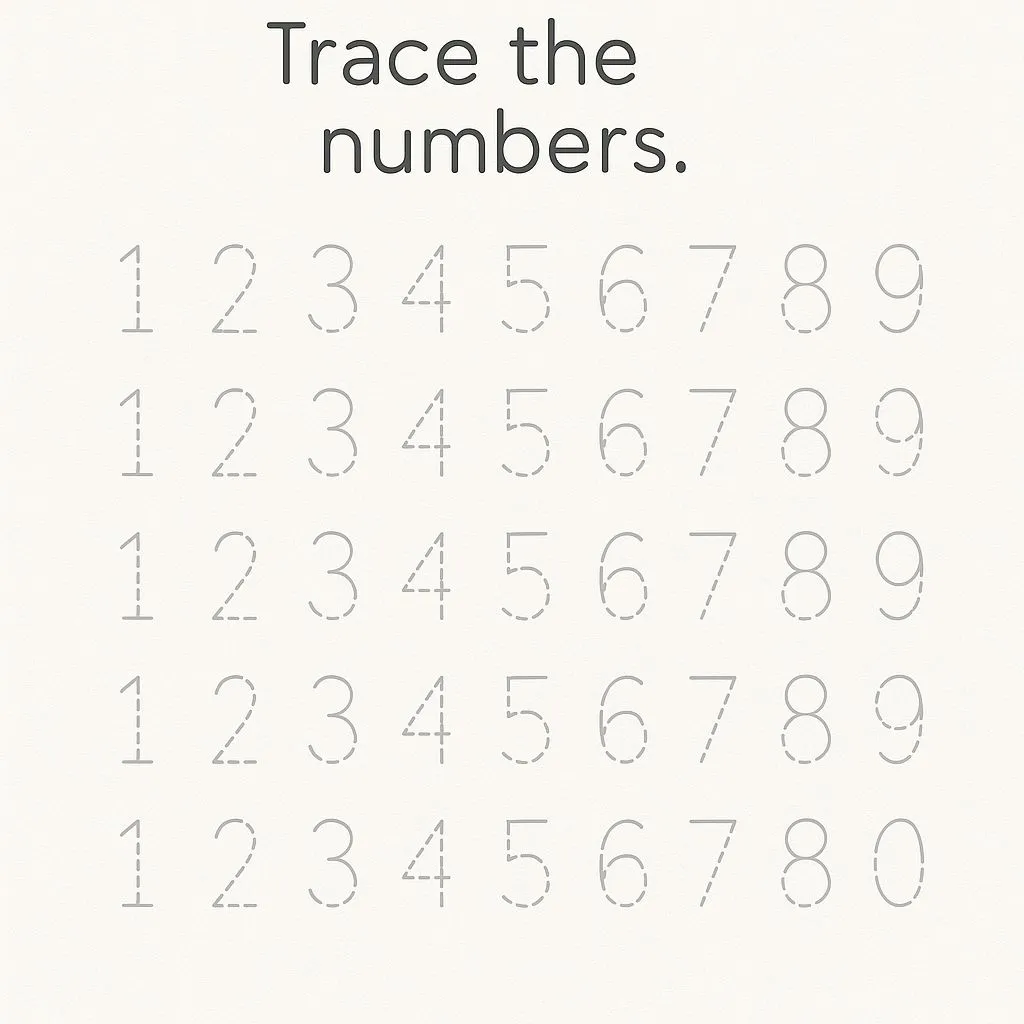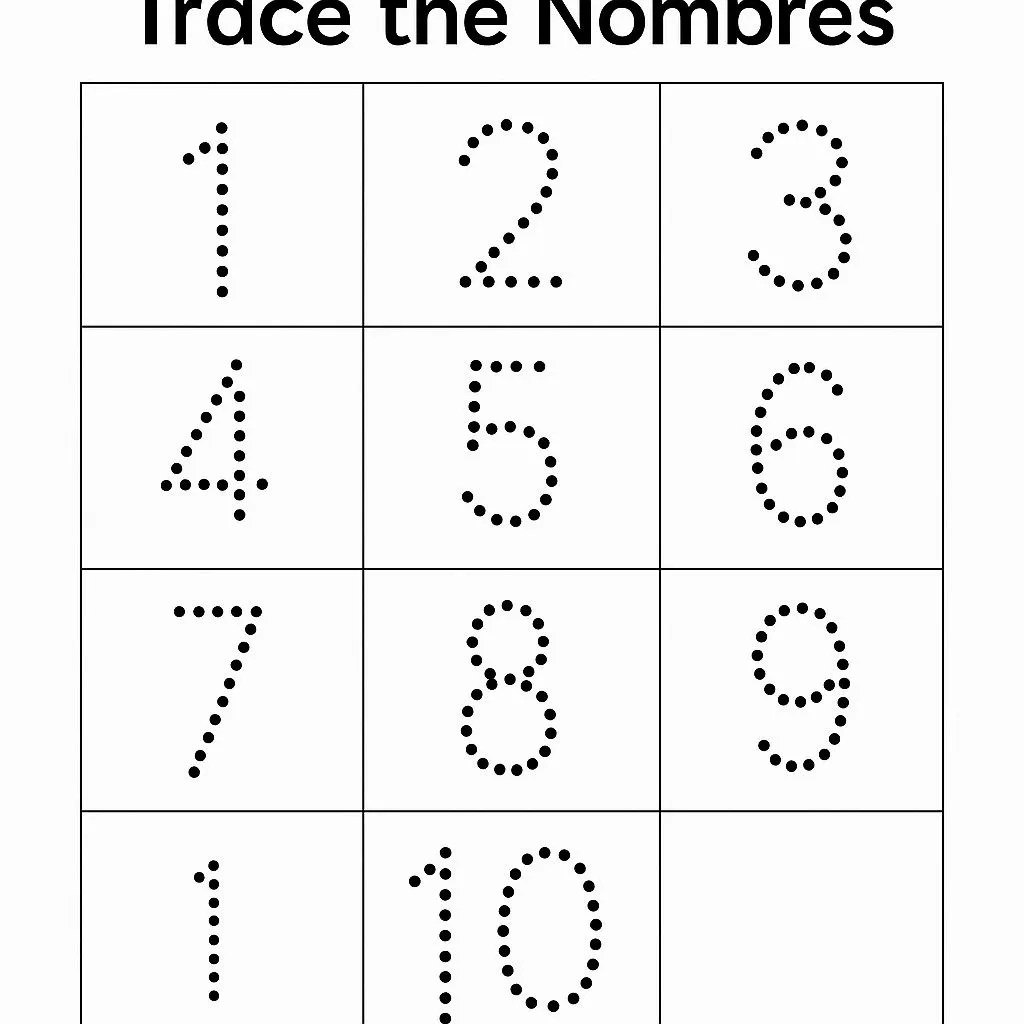Numbers 1-10 worksheets provide a crucial foundation for children beginning their mathematical journey. These carefully designed learning tools offer structured practice with the most fundamental building blocks of numeracy—the numbers one through ten. When young learners engage with quality numbers 1-10 worksheets, they develop number recognition, counting skills, and early quantitative understanding through multisensory experiences that transform abstract concepts into concrete learning. For parents and educators seeking to support early mathematics development, these printable resources offer versatility across different learning environments—from classrooms and homeschool settings to informal learning moments at the kitchen table. Unlike digital alternatives, physical numbers 1-10 worksheets provide tactile engagement that strengthens fine motor skills while reinforcing numerical concepts. Their adaptability to different learning styles and developmental stages makes them an essential component in any early childhood education toolkit, creating a solid foundation upon which all future mathematical understanding will be built.
The Developmental Impact of Numbers 1-10 Worksheets
Click on picture to get your PDf
Numbers 1-10 worksheets do far more than teach children to count—they develop multiple interconnected mathematical skills that form the foundation for more advanced concepts. When children engage with these worksheets regularly, they build:
- Number recognition: Learning to identify written numerals by their unique shapes
- One-to-one correspondence: Understanding that each number represents a specific quantity
- Sequencing ability: Grasping the proper order of numbers in our counting system
- Quantity comprehension: Developing an intuitive sense of how many items « three » or « seven » represents
- Fine motor skills: Strengthening hand muscles through tracing, coloring, and writing numbers
- Visual discrimination: Distinguishing between similar-looking numerals (like 6 and 9)
Brain Development Through Numbers 1-10 Worksheets
Research consistently shows that early experiences with numbers create neural pathways that support mathematical thinking throughout life. When children use numbers 1-10 worksheets, their developing brains form connections between:
- Visual processing centers: Recognizing number symbols
- Language areas: Connecting number words to symbols
- Spatial reasoning regions: Understanding quantity relationships
- Motor control systems: Developing physical number-writing skills
These integrated pathways create a robust foundation for numerical understanding that supports all future mathematical learning. The structured practice provided by numbers 1-10 worksheets helps strengthen these critical neural connections.
Types of Numbers 1-10 Worksheets for Different Learning Stages
Beginners (Ages 2-3)
For children just starting to explore numbers, effective numbers 1-10 worksheets feature:
- Number Recognition Activities: Large, clear numerals with distinct shapes for visual familiarity
- Counting Practice with Small Numbers: Simple counting activities with 1-3 objects initially
- Number Tracing Guides: Large dotted numbers with directional arrows showing proper formation
- Sensory Number Experiences: Worksheets designed for finger tracing or adding textured materials
- Simple Matching Activities: Connecting numerals to corresponding quantities of familiar objects
These beginning numbers 1-10 worksheets should incorporate:
- Extra-large numerals and images
- Limited focus on just 1-3 numbers initially
- Familiar objects that interest young children
- Uncluttered layouts with clear visual organization
- Thick lines suitable for developing fine motor skills
Developing Number Sense (Ages 4-5)
As children build confidence with basic counting, numbers 1-10 worksheets can introduce:
- Number Writing Practice: Structured opportunities to form numerals with decreasing guidance
- Count and Color Activities: Identifying and coloring specific quantities to reinforce one-to-one correspondence
- Number Order Exercises: Arranging numbers in sequence or identifying missing numbers
- Quantity Discrimination: Comparing groups to determine more/less/equal
- Simple Addition Readiness: Combining small groups of objects within 10
- Number Word Recognition: Connecting written number words with numerals and quantities
Advanced Number Concepts (Ages 5-7)
For children solidifying their understanding of numbers 1-10, worksheets can extend to:
- Number Bonds: Exploring different ways to compose and decompose numbers within 10
- Number Line Activities: Using number lines to develop understanding of relative value
- Skip Counting Foundations: Introducing counting by 2s and 5s using visual supports
- Simple Addition and Subtraction: Using numbers 1-10 to solve basic operations
- Pattern Recognition: Identifying and extending number patterns within 10
Maximizing the Effectiveness of Numbers 1-10 Worksheets
Implementation Strategies
To get the most educational value from numbers 1-10 worksheets:
- Establish Regular Practice: Set aside consistent, brief periods for focused number work
- Use Proper Sequencing: Progress from simpler to more complex concepts systematically
- Incorporate Manipulatives: Pair worksheets with counting objects for concrete understanding
- Provide Verbal Reinforcement: Count aloud together while completing worksheets
- Celebrate Progress: Acknowledge improvements in recognition, counting, and writing skills
Enhancement Ideas for Numbers 1-10 Worksheets
Transform basic numbers 1-10 worksheets into richer learning experiences:
- Laminate for Reusability: Turn one-time worksheets into reusable activities with dry-erase markers
- Add Sensory Elements: Incorporate textured materials like sandpaper or fabric for tactile learning
- Create Number Portfolios: Collect completed worksheets to track progress over time
- Incorporate Movement: Add physical actions like clapping or jumping while counting
- Connect to Real Life: Relate worksheet activities to everyday counting opportunities
Creative Ways to Use Numbers 1-10 Worksheets
Standard worksheets become even more engaging with these adaptations:
Multisensory Approaches
Transform numbers 1-10 worksheets with these sensory-rich modifications:
- Textured Number Tracing: Add glue, sand, or yarn to create raised numbers for tactile feedback
- Scented Markers: Associate different numbers with distinct scents for multisensory memory
- Sound Patterns: Add clapping or tapping patterns corresponding to each number
- Movement Integration: Incorporate physical actions like jumping or hopping while counting objects
Themed Numbers 1-10 Worksheet Collections
Organize number practice around high-interest themes:
- Seasonal Counting Sets: Create themed worksheet collections around holidays or seasons
- Favorite Character Numbers: Incorporate beloved book or media characters into counting activities
- Interest-Based Worksheets: Develop custom worksheets featuring dinosaurs, vehicles, animals, or other high-interest subjects
- Food-Themed Counting: Use food illustrations that connect to nutrition discussions
- Nature-Based Numbers: Utilize natural elements like leaves, flowers, and insects in counting activities
DIY Numbers 1-10 Worksheets Using Household Materials
Creating personalized numbers 1-10 worksheets doesn’t require special equipment:
- Contact Paper Activities: Create reusable worksheets using clear contact paper over printed designs
- Recycled Cardboard Templates: Cut number shapes from cardboard for tracing and tactile exploration
- Family Photo Counting Books: Create personalized counting books using family photos
- Craft Stick Number Frames: Design counting frames using craft sticks and small objects
- Homemade Number Puzzles: Create simple puzzles connecting numerals with quantities
Conclusion
Numbers 1-10 worksheets provide a powerful foundation for developing essential early math skills. By offering structured practice with these fundamental numbers, worksheets help children build the number sense, counting abilities, and numerical understanding they need for all future mathematical learning. The key to success lies in selecting worksheets that match your child’s developmental stage and interests, then implementing them consistently in a supportive, playful environment. Remember that the journey through numbers 1-10 represents a critical developmental progression—not a race to be completed quickly. Take time to ensure mastery of these foundational concepts before moving to more advanced skills. By investing in quality practice with numbers 1-10 worksheets now, you’re setting the stage for confident mathematical thinking that will serve your child throughout their academic journey and beyond.
35 Magical Printable Holiday Coloring Sheets to Spark Joy and Creativity
FAQ About Numbers 1-10 Worksheets
Q: How do I know when my child is ready for numbers 1-10 worksheets? A: Look for signs of readiness such as interest in counting objects, recognition of some numerals in the environment, or attempts to write number-like shapes. Most children show readiness between ages 2-4, but development varies significantly. Start with simple activities focusing on just 1-3, then gradually extend to higher numbers as confidence builds. If a child seems frustrated, take a step back and try again after a few weeks, or try more playful, game-based number activities before returning to worksheets.
Q: My child can recognize numbers but struggles to write them. What numbers 1-10 worksheets would help? A: Focus on worksheets with progressive writing support. Begin with finger-tracing activities on large, textured numbers, then move to tracing dotted lines with clear directional arrows. Number formation rhymes can help children remember the proper movements (e.g., « Start at the top and down we run, that’s the way we make a one »). Provide plenty of multisensory experiences—forming numbers in sand, salt trays, or shaving cream before using pencil and paper. Remember that number writing requires fine motor development, which progresses at different rates for each child.
Q: How often should we use numbers 1-10 worksheets for optimal learning? A: Quality and consistency matter more than quantity. Short, focused sessions (5-10 minutes) several times per week yield better results than occasional longer practice. Watch for engagement cues—when a child remains interested and focused, learning is occurring. When attention wanes, it’s time to conclude or switch activities. Integrate worksheet practice with hands-on counting experiences and mathematical conversations throughout the day for balanced development. Most importantly, keep the experience positive and pressure-free to foster a healthy attitude toward mathematics.
Q: The numbers 1-10 worksheets I have focus only on counting. How can I expand my child’s number understanding beyond this? A: While counting is important, comprehensive number sense includes several components. Look for or create worksheets that incorporate number writing, quantity comparison (more/less), number order (sequencing), one-to-one correspondence (matching numbers to quantities), and number composition (how numbers can be made from smaller numbers). Supplement worksheet practice with real-world number experiences—counting steps while walking, discussing « more » and « less » during snack time, or finding numbers in the environment. This balanced approach develops deeper numerical understanding beyond simple counting.
Q: My child reverses numbers when writing. Should I be concerned? A: Number reversals (writing 3 backwards, confusing 6 and 9, etc.) are completely normal until around age 7. The visual-spatial skills needed to consistently orient symbols correctly develop gradually. Provide gentle, matter-of-fact correction without expressing worry. Worksheets with directional arrows, starting dots, and consistent verbal cues (« start at the top ») can help reinforce proper formation. Some children benefit from kinesthetic approaches—forming numbers with whole-body movements before attempting pencil and paper. Consistent, positive practice significantly reduces reversals over time.


